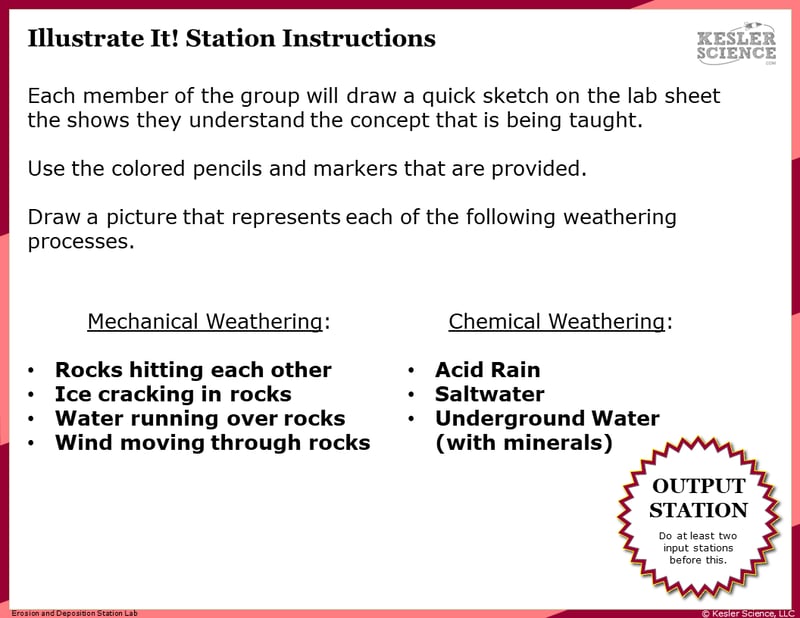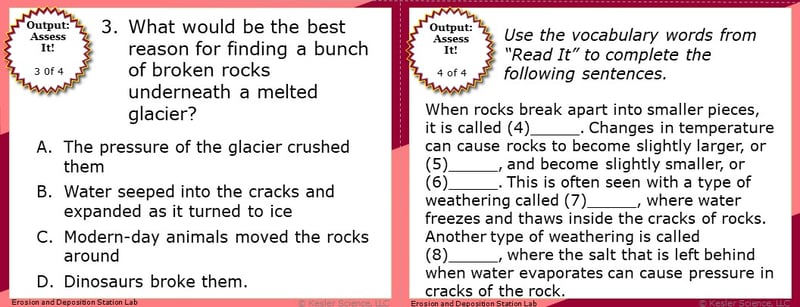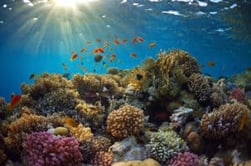Weathering and Erosion Lesson Plan - A Complete Science Lesson Using the 5E Method of Instruction
At the end of this erosion and deposition lesson plan, students will be able to analyze the effects of weathering, erosion, and deposition on the environment in ecoregions. Each of our lessons is designed using the 5E method of instruction to ensure maximum comprehension by the students. This well-thought out unit does the heavy lifting, giving teachers easy-to-implement, highly engaging lesson plans.
This blog will walk you through each of the steps and activities from the Erosion and Deposition Lesson Plan.
ENGAGEMENT
Objective Introduction
At the beginning of the lesson, the class will do a Think-Pair-Share to discuss the objective.
Class Activity
Give your students these three words and ask them to think about them as they watch a YouTube video about Weathering, Erosion, and Deposition.
Student Activity
- Have students work with a partner to answer either the questions given to you or your own guided questions.
- Ask them to use the words weathering, erosion, and deposition to describe what was happening in the video?
- Ask for responses from each group.
- Explain that over the next few days, students will be learning about weathering, erosion, and deposition and how it is affected by ecoregions on earth.

The teacher will then help to clear any misconceptions their students have about weathering and erosion. A common but major misconception, for example, is that students will have no concept of how erosion transports large objects (boulders).
Estimated Class Time for the Engagement: 20-30 minutes
EXPLORATION
With nine stations in total, you can introduce weathering and erosion to your middle school students in a variety of ways! Four of these stations are considered input stations where students will learn new information about weathering and erosion, and four of the stations are output stations where students will be demonstrating their mastery of the lesson's material. A bonus station offers challenges for your early finishers and independent learners. You can read more about how I set up the station labs here.
Watch It!
At this station, students will be watching a short video explaining weathering and erosion. Students will then answer questions related to the video and record their answers on their lab station sheet. For example: According to the video, what is weathering? What is the difference between mechanical weathering and chemical weathering? How can water impact a shoreline?
Read It!
This station will provide students with a one-page reading about weathering of rocks. In the reading, students will learn how mechanical weathering is the natural process in which temperatures and the environment can break down rocks into smaller pieces. There are four follow-up questions that the students will answer to demonstrate their comprehension of the reading material.
Explore It!
Students will be working in pairs to better understand how erosion and weathering occur by two different methods. Students will be modeling mechanical weathering using a container and a sugar cube. Students will also be making observations explaining what they see during chemical weathering. Students will record their observations on their lab sheet.
Research It!
The research station will allow students to find out information about erosion and deposition. Students will be able to click and drag pictures to put in order of least amount of erosion to the most amount of erosion. Students will be helped along the way if they miss a step. After students have correctly placed the pictures in the right order, the pictures will animate and show the students the process of erosion.
Organize It!
The Organize It station allows your students to organize key vocabulary terms with the correct descriptions. This will allow the teacher to see if the students understand terms relating to earthquakes.
Illustrate It!
Your visual students will love this station. Students will sketch and label diagrams that represent both mechanical and chemical weathering. Students will also label factors that cause these types of weathering on their diagram.

Write It!
Students who can answer open-ended questions about the lab truly understand the concepts that are being taught. At this station the students will be answering three task cards like: Describe how acid rain would react with rocks over time. Describe why rocks found at the bottom of a river are smooth and flat. What is erosion?
Assess It!
The Assess It station is where students will go to prove mastery over the concepts they learned in the lab. The questions are set up in a standardized format with multiple choice answers. Some questions will ask students: Which process is not chemical weathering? Which process is not mechanical weathering? What would be the best reason for finding a bunch of broken rocks underneath a melted glacier? What is erosion?

Challenge It! - Bonus Station
Early finishers and advanced students will love the extension activities in this station. Four activity choices offer them ways to expand their learning through mini-games and mini-projects.
Estimated Class Time for the Exploration: One or two 45-minute class periods
EXPLANATION
The explanation activities will become much more engaging for your class once they’ve completed the exploration station lab. During the explanation piece of the lesson, the teacher will be clearing up any misconceptions their students may have about weathering and erosion with a variety of materials. These materials include on-level and modified versions of the interactive presentation (may be used individually or projected), anchor charts, and paper or digital interactive notebook activities. If you have students that need modified notes, the 5E lessons come equipped to help give every student access to the lesson.
Interactive notebook samples: Above-left is a digital INB activity slide; above-right is an example of the paper INB activities.
The students will also be interacting with their journals using INB templates for erosion and deposition. Each INB activity is designed to help students compartmentalize information for a greater understanding of the concept. The erosion and deposition INB templates allow students to focus their notes on the types of weathering.
Estimated Class Time for the Exploration: Two or three 45-minute class periods
ELABORATION
The elaboration section of the 5E method of instruction gives students choices that allow them to prove they’ve mastered the concepts behind the lesson. When students are given a choice, they’re much more enthusiastic and invested in the project than they are when their teachers choose their projects for them. There are a total of nine choices to demonstrate understanding of weathering and erosion. A separate set of choices that offer more teacher support are also available for students that need them. Rubrics guide students to doing their best work and assist in grading.

Estimated Class Time for the Elaboration: Two or three 45-minute class periods (can also be used as an at-home project)
EVALUATION
The final piece of the 5E model is to evaluate your students' comprehension. Included in every 5E lesson is a homework assignment, assessment, and modified assessment. Research has shown that homework needs to be meaningful and applicable to real-world activities in order to be effective. When possible, I like to give open-ended assessments to truly gauge the student’s comprehension.
Estimated Class Time for the Elaboration: One 45-minute class period
DOWNLOAD THE FULL LESSON NOW
Download Over $100 in FREE Resources
For Middle School Science
Simply create a login below and gain immediate access to a selection of our Kesler Science product line worth $100 - for FREE. There's a full version of every product type! You'll also join tens of thousands of middle school science teachers who receive timely tips and strategies straight to their inbox.







